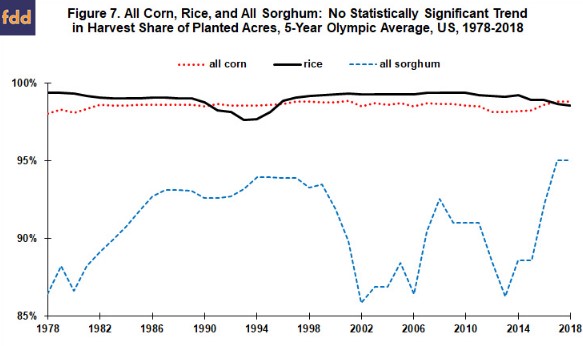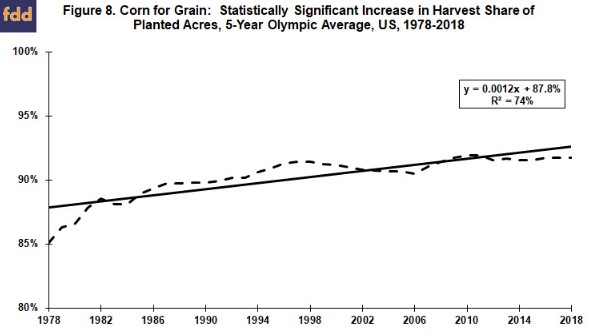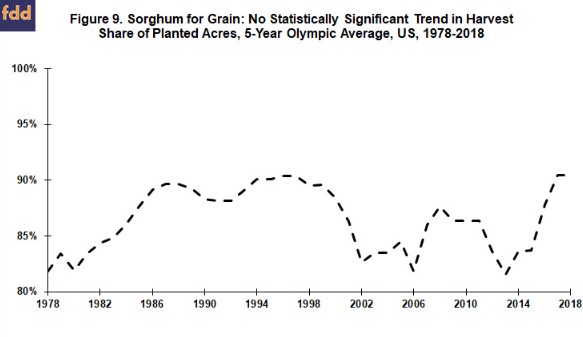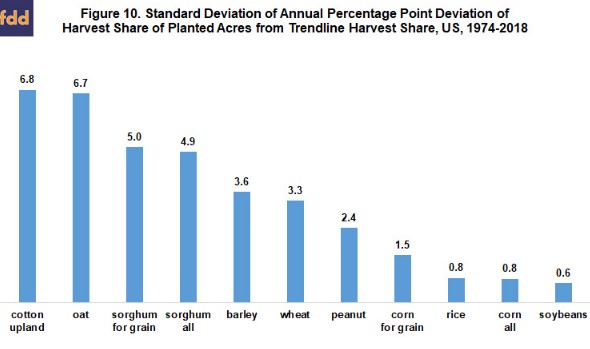By Carl Zulauf
The difficult 2019 growing season shined a spotlight on issues normally of secondary interest. This article probes one of them: harvest share of planted acres, specifically of barley, corn, upland cotton, oats, peanuts, rice, sorghum, soybeans, and wheat. Only for soybeans and corn harvested for grain has harvested share statistically significantly increased since 1974. Harvest share has significantly declined for oats, barley, upland cotton, wheat, and peanuts. No significant trend exists for all corn, rice, all sorghum, and sorghum for grain. Given that this analysis is an initial probe, the article ends with a set of questions.
Data and Procedures: Data used in this analysis are from Quickstats (US Department of Agriculture, National Agricultural Statistics Service (USDA, NASS)). Long-term trends are of interest; thus a 5-year Olympic average (5OA) of values for the current and past 4 years is used instead of individual year values. An Olympic average removes the high and low values before calculating the average. Both averaging and removing extreme values dampen variability. The analysis starts with the 1974 market year and ends with the 2018 or last completed market year. Choice of the starting year reflects the increase in price variability after 1973.
Soybeans: From 1978, the first market year for which a 5OA is calculated, through 2018, 5OA harvest share of planted acres trended up for US soybeans (see Figure 1). The trend is significant with 99% statistical confidence. Annual trend increase is +0.03 percentage point (pp) per year. This may seem small, but 5OA trendline harvest share rose by 1.2 pp over the analysis period (from 97.7% in 1978 to 98.9% in 2018). This 1.2 pp increase translates into 55 million more bushels of soybeans in 2018, or a 6% increase in US soybean stocks carried out of 2018.
Oats: 5OA harvest share of acres planted to oats is trending lower with 99% statistical confidence (see Figure 2). Rate of decline is -0.88 pp / year. Trendline 5OA harvest share dropped from 69% in 1978 to 33% in 2018. The 33% trendline share in 2018 prompts the question, “Is oats in the US now planted more as a cover crop than as a production crop?”
Barley: 5OA harvest share of US acres planted to barley is trending lower with 99% statistical confidence (see Figure 3). Rate of decline is -0.21 pp / year. Trendline 5OA harvest share declined from 94% in 1978 to 86% in 2018. The rate of decline may have accelerated since it is -0.37 pp / year since 2000.
Upland Cotton: 5OA harvest share of US acres planted to upland cotton is trending lower with 99% statistical confidence (see Figure 4). Rate of decline is -0.29 pp / year. Trendline 5OA harvest share dropped from 96% in 1978 to 84% in 2018. The decline has largely occurred since the late 1990s, but caution is in order regarding upland cotton’s trend due to the large variation around the 5OA trendline.
Wheat: 5OA harvest share US acres planted to wheat is trending lower with 99% statistical confidence (see Figure 5). Rate of decline is -0.08 pp / year. Trendline 5OA harvest share declined from 87% in 1978 to 84% in 2018.
Peanuts: 5OA harvest share of US acres planted to peanuts is trending lower with 99% statistical confidence (see Figure 6). Rate of decline is -0.05 pp / year. Trendline 5OA harvest share declined from 98% in 1978 to 96% in 2018.
All Corn, Rice, and All Sorghum: No statistically significant trend exists in the 5OA harvest share of US acres planted to all corn, rice, and all sorghum (see Figure 7). A linear trend explains only 3%, 1%, and 0%, respectively, of the year-to-year variation in harvest share. For all corn and all sorghum, harvest share includes acres harvested for grain and for silage.

Corn and Sorghum for Grain: In 2018, 92% and 89% of acres planted to corn and sorghum, respectively, were harvested for grain. Thus, the trend in share of corn and sorghum acres harvested for grain is also examined. For corn, this share is trending up with 99% statistical confidence (see Figure 8). Rate of increase is +0.12 pp / year. Trendline 5OA harvest share rose from 88% in 1978 to 93% in 2018. This 5 pp increase translates into 727 million more bushels of corn in 2018. For sorghum, no statistically significant trend exists as a linear trend explains none of the year-to-year variation in the share of planted sorghum acres harvested for grain (see Figure 9).


Annual Variation in Harvest Share across Crops: 5OA smooths the variation in harvest share of planted acres, but, as Figures 1-9 reveal, considerable variability still exists for some of the crops. To further investigate this variation, standard deviation of the annual percentage point deviation of the observed annual share from its linear regression trendline value is calculated and expressed as a percent of the trendline value. (See Data Note 1 for further discussion of the analytical method used in this analysis.) Upland cotton and oats, followed by sorghum, have the largest annual variation in harvest share of planted acres from its trendline value (see Figure 10). Soybeans, corn, and rice have the smallest annual variation. Annual variation against trend is more than 10 times larger for upland cotton and rice than for soybeans. The higher a crop’s standard deviation, the more important it is to track harvest share of planted acres since harvest share has a greater impact on amount of the crop produced and thus its price. To summarize, annual variation in harvest share of planted acres is a more important pricing factor for upland cotton, oats, and sorghum than for corn, rice, and soybeans.

Summary Observations:
Long-term trend in the share of planted acres that is harvested varies notably across the 9 large acre field crops examined in this study.
Harvest share of planted acres has trended upward since 1974 with statistical significance only for soybeans and corn harvested for grain.
Annual variation in harvest share of planted acres from its estimated trend value also varies widely across the 9 crops. Harvest share varies more for cotton, oats, and sorghum than the other crops. It varies relatively little for soybeans, corn, and rice. Harvest share’s importance as a price-determining factor thus varies by crop.
Inputs applied to a crop that is planted but not harvested is a loss and must be recouped with higher returns in years when the crop is harvested if the farm is to remain in business.
Investigation of why crops are planted but not harvested appears warranted to better understand farm management decisions and to identify the factors that explain the large variation in long-term trends and annual variability across the crops analyzed in this study.
The findings of this study prompt 5 questions for further discussion and investigation.
- Do trends in harvested share of planted acres vary by US geographical area?
- What, if any, role does planting a crop as a cover crop play in the trends observed in this study, particularly for small grains?
- Given the increasing discussion of cover crops as an agronomic management practice, should NASS begin surveying the planting of cover crops?
- What, if any, role does the elimination of annual acreage set aside programs in the 1996 farm bill play in explaining either the observed trend in harvested share of planted acres for a given crop or the variability across crops?
- What, if any, role does the crop insurance program play in explaining either the observed trend in harvested share of planted acres for a given crop or the variability across crops?
Data Note 1: A linear trendline regression equation was estimated for each crop using its individual year values from 1974 through 2018. A linear trend value was calculated for each year using the estimated regression equation. Average harvest share for 1974-2018 was used if the linear trend was not significant with 95% statistical confidence. Statistical significance of a linear trend is the same for individual year and 5OA values for all crops except peanuts. Peanuts’ harvest share using individual year values trended lower with 94% statistical confidence, just below the 95% test level used in this analysis. Deviation of the observed annual harvest share from its trendline harvest share was calculated and expressed as a percent of the trendline share. Standard deviation of these annual percentage point deviations from trend was calculated for each crop and is reported in Figure 10.
Source : farmdocdaily